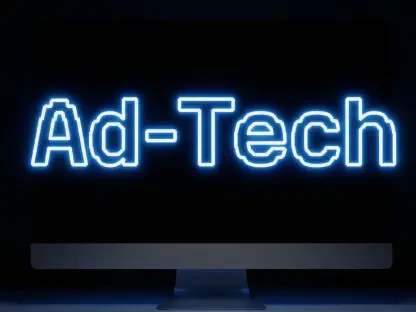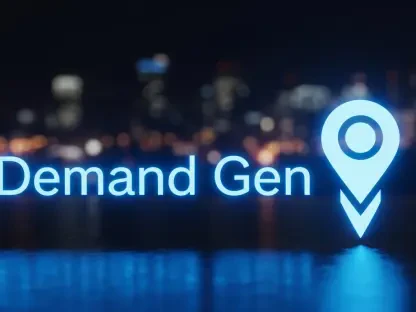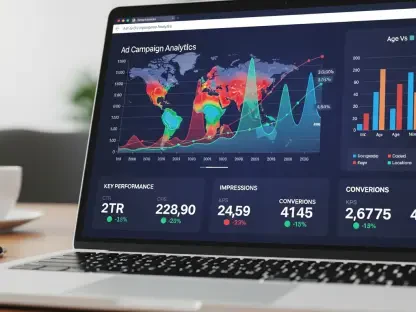Imagine a world where every ad placement during a live sports broadcast captures the peak of viewer excitement, such as a game-winning goal, ensuring maximum engagement and revenue. This scenario is no longer a distant dream but a reality with Harmonic’s VOS360 Ad SaaS, a platform redefining video advertising monetization in the media and broadcasting industry. As digital platforms like Connected TV (CTV) and streaming services overtake traditional linear TV, the challenge of optimizing ad revenue in a fragmented landscape has become paramount. This review explores how VOS360 leverages artificial intelligence (AI) and programmatic advertising to address these challenges, offering broadcasters and streamers a powerful tool to bridge old and new media ecosystems.
Core Features and Technological Breakthroughs
AI-Powered Contextual Ad Placement
At the heart of VOS360 Ad SaaS lies its ability to analyze video content in real time, pinpointing high-engagement moments for ad insertion. During a live soccer match, for instance, the platform can detect a goal celebration and trigger an ad at that precise moment, capitalizing on heightened viewer attention. This contextual triggering significantly boosts cost-per-thousand impressions (CPMs), providing publishers with a direct path to increased revenue.
Beyond just timing, the AI ensures that ads align with the content’s tone and context, enhancing brand safety for advertisers. This sophisticated approach minimizes the risk of misplaced ads, a common issue in automated systems, and sets a new standard for relevance in video advertising. The technology’s precision offers a competitive edge in an industry where viewer retention is critical.
Seamless Programmatic and Hybrid Integration
Another standout feature is VOS360’s compatibility with leading ad tech platforms like Google Ad Manager and SpringServe. This integration allows for smooth programmatic transactions across diverse formats, including linear TV, CTV, and streaming services. Such flexibility ensures that broadcasters can monetize content uniformly, regardless of the delivery medium.
The hybrid nature of the platform addresses the industry’s transition from traditional to digital models. By supporting both legacy and modern advertising workflows, VOS360 enables media companies to maintain revenue streams from existing audiences while tapping into the growing digital ad market. This adaptability is essential in a landscape marked by rapid technological shifts.
Market Dynamics and Industry Impact
The video advertising sector is undergoing a profound transformation, with digital platforms capturing an ever-larger share of ad spending compared to linear TV. Trends such as hyper-personalized advertising and the rise of AI-driven programmatic markets, projected to reach $1.2 trillion by 2027, underscore the urgency for innovative solutions. VOS360 positions itself as a frontrunner by aligning with these shifts, offering tools that anticipate future demands.
A key driver of this evolution is the surge in CTV ad spending, expected to exceed $46 billion by 2028. VOS360’s focus on low-latency delivery and dynamic ad formats, such as overlays, caters directly to this growing segment. Its ability to deliver targeted, high-quality ads in real time places it at the forefront of industry advancements.
Moreover, the platform’s emphasis on operational efficiency resonates with broadcasters facing tighter budgets. By automating complex processes like ad insertion, it reduces costs while maintaining high standards of delivery, making it a vital asset for companies navigating competitive pressures in the media space.
Performance in Real-World Scenarios
Practical applications of VOS360 Ad SaaS reveal its tangible benefits for media organizations. During the Campeonato Brasileiro Série A, Brazil’s Globoplay utilized the platform to achieve a remarkable 50% reduction in bandwidth costs alongside a 25% increase in ad yield. These results highlight the system’s capacity to optimize both financial and technical performance under high-demand conditions.
In another instance, a regional sports network adopted VOS360 for automated ad insertion during live games, slashing operational costs by 30%. This efficiency stems from the platform’s ability to streamline workflows, eliminating manual intervention and reducing error rates. Such outcomes demonstrate its value in diverse broadcasting environments.
These case studies reflect a broader pattern of success, where the technology not only enhances revenue but also simplifies the complexities of modern ad delivery. For companies managing large-scale events or niche content, VOS360 offers a reliable solution to balance quality and cost.
Challenges and Areas of Concern
Despite its strengths, VOS360 Ad SaaS faces notable hurdles in a fragmented market dominated by walled gardens like Amazon and Roku. These closed ecosystems limit cross-platform ad delivery, posing a barrier to seamless integration. Harmonic has responded with an Open Garden framework, aiming to foster interoperability, though full resolution of this issue remains a work in progress.
Data quality also presents a challenge, as inaccuracies can undermine the effectiveness of contextual ad placement. To counter this, Harmonic has introduced transparent reporting tools to ensure accountability and build trust with partners. While these measures show promise, consistent data reliability across varied sources is still an area needing refinement.
Navigating these obstacles is crucial for the platform’s sustained growth. As the industry evolves, Harmonic’s ability to adapt to competitive dynamics and technical constraints will determine how effectively VOS360 maintains its edge over rivals.
Looking Ahead: Growth and Innovation Potential
The future trajectory of VOS360 Ad SaaS appears promising, with potential advancements in AI capabilities poised to further enhance ad personalization. Dynamic formats like L-shaped ads could become more prevalent, offering immersive experiences that captivate viewers. Such innovations are likely to drive even higher engagement rates in the coming years.
Scalability remains a priority, bolstered by partnerships such as the qualification on Akamai Cloud. This collaboration ensures the platform can handle spikes in demand, particularly during major live events, without compromising on speed or quality. This infrastructure support is vital for maintaining reliability at scale.
As the programmatic advertising landscape continues to expand, VOS360 is well-positioned to capture a significant share of the market. Its focus on integrating cutting-edge tech with practical monetization strategies suggests a lasting impact on how media companies approach revenue generation in an increasingly digital world.
Final Thoughts and Recommendations
Reflecting on the evaluation, Harmonic’s VOS360 Ad SaaS proved to be a transformative force in video advertising, delivering impressive results in revenue optimization and operational efficiency. Its AI-driven contextual ad placement and programmatic integration stood out as key strengths, validated by real-world successes like those seen with Globoplay. Financially, Harmonic’s robust performance, with Video SaaS revenue hitting $15.4 million in Q2, underscored strong market confidence.
Moving forward, media companies should consider adopting this platform to stay ahead in a rapidly shifting industry, focusing on leveraging its automation capabilities to cut costs. For Harmonic, prioritizing solutions to data quality issues and market fragmentation through enhanced transparency and broader partnerships will be essential. Exploring deeper AI innovations could further solidify VOS360’s role as a leader, ensuring it continues to shape the future of media monetization.









